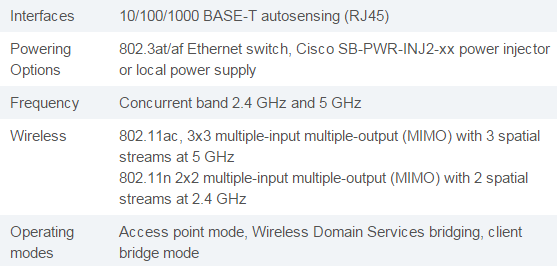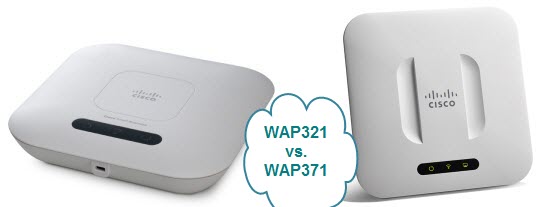
Besides the new WAP351, the Cisco Small Business 300 family also has the WAP321 and WAP371. The Small Business 300 Series Wireless Access Points are easy to deploy in a wireless network. These Cisco 300 Wireless APs for small business offer 802.11n or 802.11n/ac wireless connectivity with a dual concurrent radio or a selectable single radio. They deliver faster Wi-Fi and guest access services that are affordable, highly secure, and reliable—without a hardware controller. In this article, we will compare the two Small Business 300 wireless AP models, the Cisco WAP321 and WAP371. Before comparing, let’s have a quick look at the main bright features of them.
Key features and benefits-Cisco WAP371:
- Provides 802.11ac wireless connectivity up to three times the 802.11n speed
- Gigabit Ethernet LAN interface with Power over Ethernet (PoE) supports flexible installation
- Captive portal allows for highly secure guest access with customized roles and rights
- Single Point Setup requires no controller for easy deployment of multiple access points
- Works right out of the box with easy installation and simple web-based configuration and wizard
WAP371-More Specifications
Cisco 300 Model Comparison-WAP321 vs. WAP371
| Product | WAP321 | WAP371 |
| Device type | Wireless access point | Wireless access point |
| Built-in devices | N/A | N/A |
| Ruggedized design | N/A | N/A |
| Width | 6.7 in | 9.05 in |
| Depth | 6.7 in | 9.05 in |
| Height | 1.4 in | 1.69 in |
| Weight | 9.7 oz | 1.18 lb |
| Localization | United States | United States |
| Processor / Memory / Storage | ||
| Hard drive | None | None |
| RAM installed (max) | 64 MB | 64 MB |
| Flash memory installed (max) | 16 MB | 32 MB |
| Networking | ||
| Form factor | None metal | None metal |
| Connectivity technology | Wireless N | Wireless AC |
| Data transfer rate | 300 Mbps | 300 Mbps for 802.11n 850 Mbps for 802.11ac |
| Line coding format | N/A | N/A |
| Data link protocol | IEEE 802.11b, IEEE 802.11g, IEEE 802.11n | IEEE 802.11b, IEEE 802.11g, IEEE 802.11n, IEEE 802.11ac |
| DFS support | No | No |
| Spread spectrum method | OFDM | OFDM |
| Remote management protocol | Telnet, SNMP 3, HTTP, HTTPS, SSH | Telnet, SNMP 3, HTTP, HTTPS, SSH |
| Network / transport protocol | DHCP, Bonjour | DHCP, Bonjour |
| Frequency band | 2.4 GHz or 5 GHz | 2.4 GHz and 5 GHz |
| MIMO | 2×3 | 3×3 for 5 GHz and 2×2 for 2.4 GHz |
| Maximum active WLAN clients | 32 | 32 |
| Number of access points supported per cluster | 8 | 8 |
| Status Indicators | Power, WLAN, LAN | Power, WLAN, LAN |
| Features | DHCP support, load balancing, VLAN support, Syslog support, email alert, IPv6 support, Wireless Distribution System (WDS) support, firmware upgradable, wall mountable, Spanning Tree Protocol (STP) support, Wi-Fi Multimedia (WMM) support, access control list (ACL) support, quality of service (QoS), RADIUS support, Wi-Fi Protected Setup (WPS), Multiple SSID support, wireless bridge mode, IPv4 support,rogue access point detection, captive portal, Single Point Setup | DHCP support, load balancing, VLAN support, Syslog support, email alert, IPv6 support, Wireless Distribution System (WDS) support, firmware upgradable, wall mountable, Spanning Tree Protocol (STP) support, Wi-Fi Multimedia (WMM) support, access control list (ACL) support, quality of service (QoS), RADIUS support, Wi-Fi Protected Setup (WPS), Multiple SSID support, wireless bridge mode, IPv4 support, rogue access point detection, captive portal, Single Point Setup |
| Roaming | 802.11r (when supported by driver) | 802.11r (when supported by driver) |
| Encryption algorithm | WPA, WPA2 | WPA, WPA2 |
| Authentication method | RADIUS, Radio Service Set ID (SSID) | RADIUS, Radio Service Set ID (SSID) |
| Compliant standards | IEEE 802.3, IEEE 802.3u, IEEE 802.1Q, IEEE 802.11b, IEEE 802.3af, IEEE 802.11d, IEEE 802.11g, IEEE 802.1x, IEEE 802.11i, IEEE 802.11e, IEEE 802.11n, Wi-Fi Protected Setup | IEEE 802.3, IEEE 802.3u, IEEE 802.1Q, IEEE 802.11b, IEEE 802.3af, IEEE 802.11d, IEEE 802.11g, IEEE 802.1x, IEEE 802.11i, IEEE 802.11e, IEEE 802.11n, Wi-Fi Protected Setup |
| Antenna | ||
| Antenna | Internal integrated | Internal integrated |
| Antenna quality | N/A | N/A |
| Directivity | N/A | N/A |
| Gain level | 2 dBi | 2 dBi |
| Expansion / connectivity | ||
| Interfaces | 1 x network / power – Ethernet 10Base-T/100Base-TX/1000Base-T – RJ-45 | 1 x network / power – Ethernet 10Base-T/100Base-TX – RJ-45 |
| Miscellaneous | ||
| Cables included | 1 x network cable | 1 x network cable |
| Mounting kit | Included | Included |
| Compliant standards | FCC Class B certified, IC | FCC Class B certified, IC |
| Power | ||
| Power over Ethernet (PoE) supported | 802.3af | 802.3af/at |
| Power device | Power adapter – external ( not included) | Power adapter – external (not included) |
| Voltage required | DC 12 V1A | DC 12 V2A |
| Software / system requirements | ||
| OS provided | Linux | Linux |
| Mean time between failure (MTBF) | 68248 | 50,000 |
| Manufacturer warranty | Limited lifetime warranty | Limited lifetime warranty |
| Service and support | Cisco Small Businees Support Center (SBSC) | Cisco Small Businees Support Center (SBSC) |
| Service and support details | Cisco Small Business Support Service | Cisco Small Business Support Service |
| Environmental parameters | ||
| Minimum operating temperature | 32° F | 32° F |
| Maximum operating temperature | 104° F | 104° F |
| Humidity range operating | 10 – 85% (non-condensing) | 10 – 85% (non-condensing) |
More about Cisco Small Business 300 Wireless Access Point




